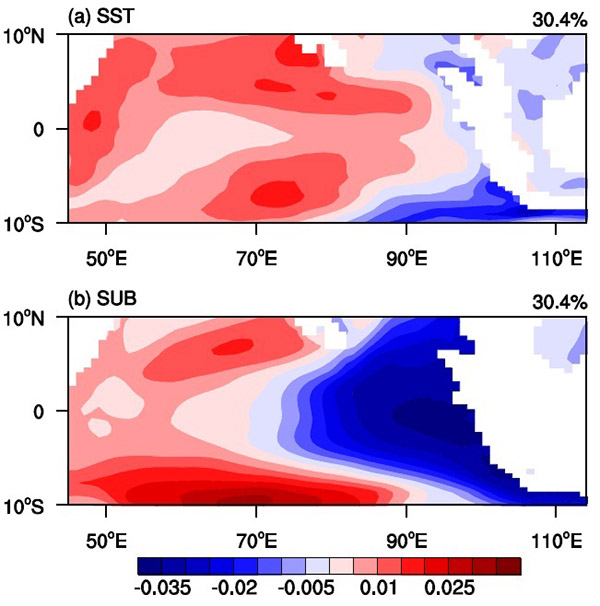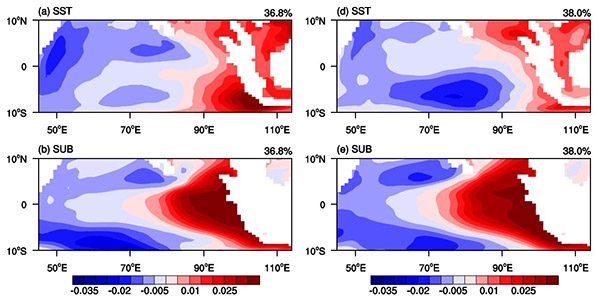State Key Laboratory of Numerical Modeling for Atmospheric Sciences and
Geophysical Fluid Dynamics (LASG)
Institute of Atmospheric Physics, Chinese Academy of Sciences

Vol. 3/No.3 August 2017
Relationship between optimal precursors for Indian Ocean Dipole events and optimally growing initial errors in its prediction
The Indian Ocean Dipole (IOD) is an important ocean–atmosphere coupled phenomenon in the tropical Indian Ocean.It can not only regulate the monsoons and thus affect the climate and weather of nearby regions but also affect distant areas by the propagation of planetary waves.The lead time for skillful IOD predictions is only one season, and the low forecast skill may have a close relationship with the winter predictability barrier (WPB). Apart from the WPB phenomenon, the precursor is another important issue in the predictability of the positive IOD. The study of the precursor is important for identifying the IOD in advance and therefore improving the forecast skill.
Recently, Prof. MUMu (Fudan University), Dr. FENGRong (Institute of Atmospheric Physics), Prof. DUANWansuo (Institute of Atmospheric Physics)have explored the relationship between the WPB-related initial errors (i.e., the optimally growing initial errors (OGEs)) and optimal precursors (OPRs) corresponding to a positive IOD.They found that there are two types ofOPRs with opposite patterns; the surface component of OPR-1 (OPR-2) is an indistinctive west–east dipole pattern. Correspondingly, there is a significant west–east dipole pattern in the subsurface component of the OPRs, with the largest values located in the eastern equatorial Indian Ocean. Furthermore, the OPRs are similar to the OGEs associated with IOD predictions. Moreover, the large values of the OPRs are located in the same areas as the sensitive areas of targeted observations identified by the OGEs. This infers that intensive observations over these areas would not only reduce initial errors, improve the accuracy of initial fields and decrease the prediction errors, but would also detect the precursory signals in advance, which substantially improves the forecast skill of IOD.

Figure 1 Spatial patterns of surface component (a) and subsurface component (b) for the leading mode of the combined empirical orthogonal function analysis of initial perturbations that are most likely to develop into the positive IOD (units: °C).

Figure 2 Spatial patterns of the surface component (a) and subsurface component (b) for the leading mode of the combined empirical orthogonal function analysis of initial errors that are most likely to cause a significant WPB for start month July (−1); (d) and (e) are for the start month July (0) (units: °C).
This study is published in Journal of Geophysical Research: Oceans (doi: 10.1002/2016JC012527).
Reference:
Mu Mu, Rong Feng, and WansuoDuan, 2017: Relationship between optimal precursors for Indian Ocean Dipole events and optimally growing initial errors in its prediction. Journal of Geophysical Research: Oceans, 122, doi:10.1002/2016JC012527.
Contact: FENG Rong, fengrong@lasg.iap.ac.cn
E-mail: lasg_newsletter@lasg.iap.ac.cn
Editors: Chuanyi Wang (wangcy@lasg.iap.ac.cn), Kangjun Chen(ckj@lasg.iap.ac.cn)